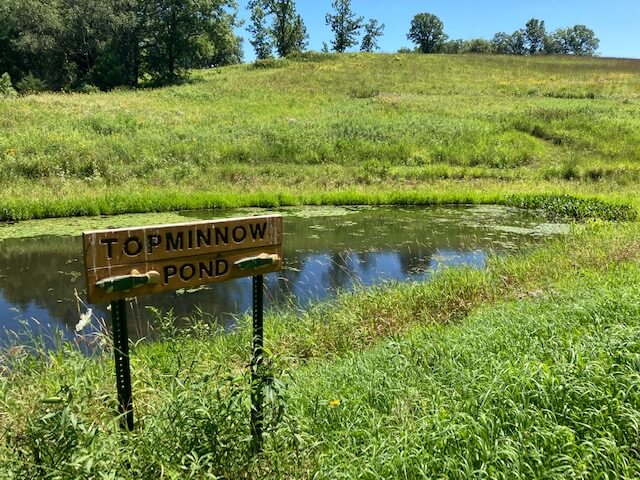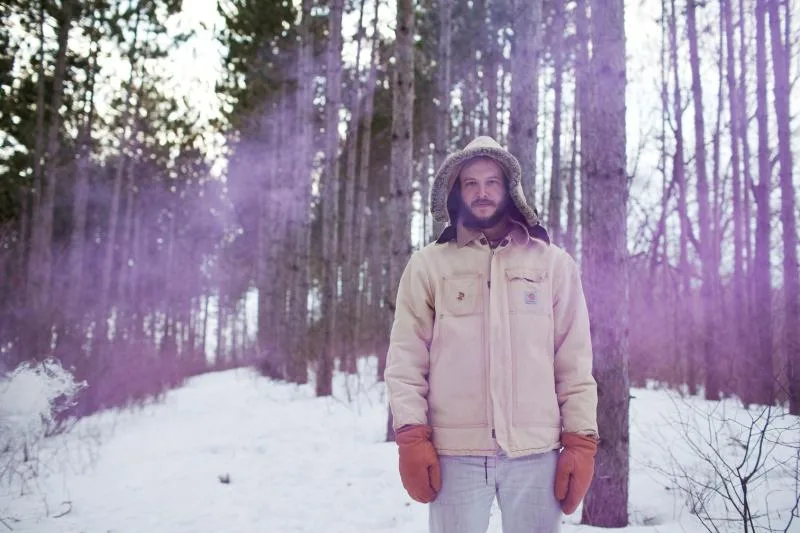
(Photo by Susan Lampert Smith)
Opportunities abound for help monitoring everything from birds and bees to turtles and toads. There’s also a new lake that someone will get to name.
The Starhead Topminnow doesn’t have the glamor of other endangered species like, say, black rhinos or pink river dolphins.
But the tiny fish, about the size of your pinkie finger, are one of our endangered species that once thrived in the waters of Wisconsin rivers such as the Black, Sugar, Fox, and Rock. They’ve been wiped out in large parts of their former range by pollution. And that alone, says a group of self-described “fish geeks,” is reason enough to give them a hand.
Five retired Department of Natural Resources (DNR) employees have been working as volunteers since 2018 to restore the Starhead Topminnow to parts of the Wisconsin River above the Prairie du Sac dam. It’s certainly the most ambitious “citizen science” effort in the state, but there are other ways to get involved in helping save—or even name—Wisconsin’s natural treasures (see below).
“We would have never been able to do this when we worked at the DNR,’’ said Dave Marshall, a water quality biologist who retired in 2006. Retired DNR fishery manager Tim Larsen agreed, saying that his group was instructed to work only on sports fishing species because fishing licenses paid for their work.
“We’re also having a lot more fun doing this as retirees,’’ said Marshall. He and his friends have made “Topminnows for Tomorrow” T-shirts and hats, a spoof of groups like “Trout Unlimited,” “Pheasants Forever,” and “Whitetails Unlimited” that support Wisconsin’s more popular wildlife species.
The Topminnow fan club may be small, but it has some mighty fishery skills. They wrote grant proposals, got an aquaculture license, and a stocking permit. In 2017, they launched Wisconsin’s first “conservation aquaculture project” by collecting about 150 little fish as “broodstock,” and rearing them in a pond on Marshall’s property south of Barneveld. Those fish reproduced until they had about 7,000 minnows ready to return to the Wisconsin River. They stocked the minnows in four backwater sloughs of Lake Wisconsin for four years in a row, from 2018 to 2021.
On a recent weekday morning, Larson steered a skiff up the Gallus Slough near Merrimac as Marshall dipped a net to check on how their minnows were faring. Marshall pulled up wiggling males, with their glistening stripes, and females fat with eggs. Another scoop brought up smaller minnows.
“These are definitely young of the year,’’ Marshall said, of the small fry. “We can definitely say they’re reproducing.”

After the ride back to the Moon Valley boat ramp, Marshall and Larson toasted their success with a cold Point Special, beer before noon being another benefit of retirement.
The retirees—who also include John Lyons, Sue Marcquenski and Jean Unmuth—have published a series of scientific papers on their project in American Currents, the journal of the North American Native Fishes Association.
The effort was so successful that they’re turning their attention to Lake Chubsuckers, another river fish listed as a species “of concern” because of water pollution. Those are growing in Marshall’s pond right now.
One sad note about the Starhead Topminnow project: The group decided not to stock the fish where they once thrived—the oxbow sloughs along the 92 miles of the Lower Wisconsin State Riverway. Marshall said the oxbows in the Spring Green area have been badly polluted by agricultural runoff seeping through the sandy soil.
Marshall said when he first started his career, before the Clean Water Act of 1972 took effect, the main channel of the Wisconsin River was extremely polluted. Today it’s so much improved that he and Larson have counted 34 species of nongame fish in Lake Wisconsin, above the dam.
Sadly, the situation is reversed on the lower riverway.
“The irony is that the fish (once) sought refuge in the oxbows,’’ he said. “Now the oxbows are polluted and the Starhead Topminnows can’t survive there.”
The hope is that with a new, thriving population above the dam these fish could be used to restock their former oxbow homes if the farm runoff problem is corrected.
In their first scientific paper on the project, the retirees acknowledge that Starhead Topminnows could be considered “dickey fish,” a term that comes from birders who describe small, nondescript, and hard-to-identify species as “dickey birds.”
“We love dickey fishes,’’ the retirees wrote. “Few people … are aware of them and even fewer can tell them apart or think much about their existence. Yet like dickey birds, dickey fishes are essential to the health and functioning of the ecosystems they inhabit. Conserving their populations is necessary if we are to have thriving populations of the sport and commercial fishes and other aquatic fauna that the public does care about.”
How You Can Help by Becoming a Citizen Scientist
Do you love dickey fishes or damselflies? Go batty over bats or mushy over mussels? The Wisconsin DNR and affiliated groups have a list of citizen-based monitoring projects that you can volunteer to help.
Charlie Draheim, a retired faculty member from Southwest Technical College, spent this summer monitoring 10 locations along the Mississippi River, from Potosi to Wyalusing State Park, as part of the Wisconsin Frog and Toad Survey.
He listened to audio recordings to learn the different calls of the dozen or so species native to Wisconsin. Draheim got familiar enough that he was able to detect the Blanchard’s Cricket Frog, an endangered species found only in Grant County, near his home along the Platte River. The best part was just getting out into Wisconsin’s wild places.
“I was out on Potosi Point, with the moon rising on the river and all these frogs all around me,’’ Draheim said. “It was almost surreal.”
Counties and lake districts also often need volunteers to keep track of lake clarity, monitor invasive species, or count fish.
Heck, you don’t even have to leave your chair. The Friends of the Lower Wisconsin Riverway (FLOW) is holding a naming contest, asking for citizen ideas to name Wisconsin’s newest lake. Entries are due by the end of August and the winner will take home $100 plus bragging rights to having named Wisconsin’s newest aquatic treasure.

The 20-acre lake, currently known by the inelegant name of the “Borrow Pit,’’ is located in the town of Mazomanie and is surrounded by the public lands of the state riverway.
It was created in 1991, when sand was “borrowed” for a project to improve Highway 78 south of Sauk City. Since then, ground water seeping through the sands filled it to a depth of about five feet. Aquatic ecologist Dave Marshall says the lake is “just pristine,’’ because it is surrounded by natural land. It has native fish that were likely swept in during Wisconsin River floods, as well as Smallmouth Bass, likely stocked by locals, and Starhead Topminnows, stocked by Marshall’s group.
The lake lacks a name or even the standard identification number normally assigned by the DNR to public waters. FLOW is taking nominations until Aug. 31, and in October, plans to submit the winner to the State Geographical Names Committee. If the committee agrees, the winning name will become official and historical.
Politics

It’s official: Your boss has to give you time off to recover from childbirth or get an abortion
Originally published by The 19th In what could be a groundbreaking shift in American workplaces, most employees across the country will now have...

Trump says he’s pro-worker. His record says otherwise.
During his time on the campaign trail, Donald Trump has sought to refashion his record and image as being a pro-worker candidate—one that wants to...
Local News

Stop and smell these native Wisconsin flowers this Earth Day
Spring has sprung — and here in Wisconsin, the signs are everywhere! From warmer weather and longer days to birds returning to your backyard trees....

Your guide to the 2024 Blue Ox Music Festival in Eau Claire
Eau Claire and art go hand in hand. The city is home to a multitude of sculptures, murals, and music events — including several annual showcases,...




